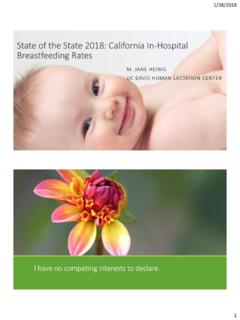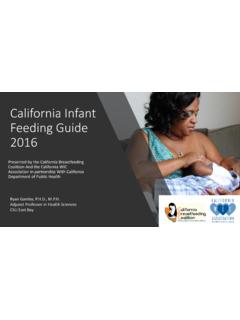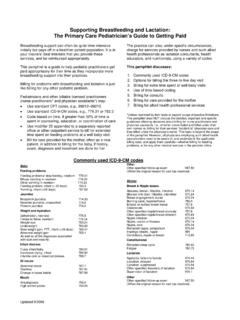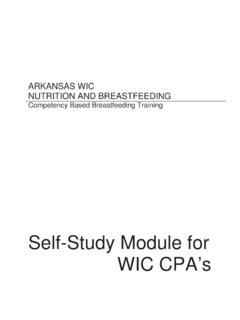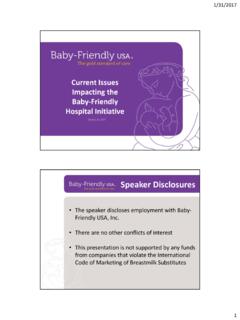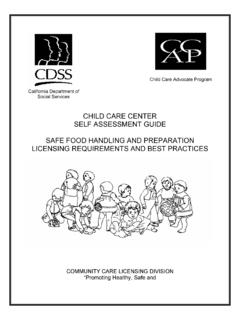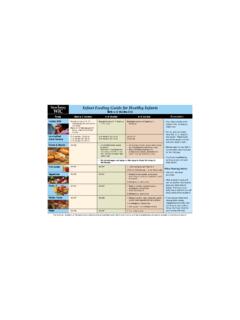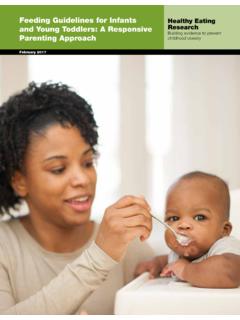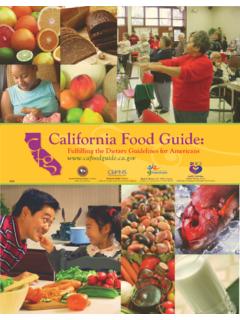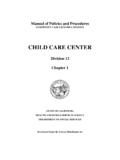Transcription of IMPROVING HOSPITAL BREASTFEEDING SUPPORT
1 IMPROVING HOSPITAL BREASTFEEDINGI mplementation ToolkitSUPPORT22 AcknowledgementsKaiser Permanente leaders across its eight geographical regions have been steadfast in their dedication to SUPPORT members who intend to breastfeed. We are grateful for the specific contributions of physicians and staff from Kaiser Permanente's HOSPITAL -based regions Northern california , Southern california , Northwest, and Hawaii who have provided their expertise, tools, and guidance toward the development of this guide and its supporting documents. Most of all, we wish to express heartfelt thanks to Kaiser Permanente members and families, who do the important work of nourishing their babies day by Review Committee Barbara Crawford, RN MSTracy Flanagan, MDEdward Martin, MDLinda Monte, RN, MNAN ancy Taquino, RN, MSND onald Dyson, MDSandi Small, RN, MSNJohn Brookey, MDBerneva Adams, MD Karen Jenkins, RNEllie Godfrey, RNKerry Grindeland, RNGregory Lee Sabin, RNAlide ChaseScott Young, MDBeth Christensen, RNLeslie Carveth, RNKeith Ogasawara, MDSusan Murray, MBA Catherine Ryan, DNP, RN, CNMLisa Schilling, RN, MPHS taffJocelyn Audelo, RN, MPHLori Friedman, MPHT rina Histon, PhDThis implementation guide and its supporting documents were developed to SUPPORT performance improvement.
2 These resources are not intended or designed as a guide for clinician and patient decisions about BREASTFEEDING and BREASTFEEDING SUPPORT , nor are they a substitute for the reasonable exercise of independent clinical judgment by practitioners, considering each patient s needs on an individual basis. Recommendations contained in this implementation guide apply to populations of patients; clinical judgment and shared decision-making are necessary to SUPPORT BREASTFEEDING plans for individual patients. 2013, Kaiser Permanente Medical Care Program. All rights Kaiser PermanenteKaiser Permanente is committed to helping shape the future of health care. We are recognized as one of America s leading health care providers and not-for-profit health plans. Founded in 1945, our mission is to provide high-quality, affordable health care services and to improve the health of our members and the communities we serve.
3 We currently serve more than 9 million members in nine states and the District of Columbia. Care for members and patients is focused on their total health and guided by their personal physicians, specialists and team of caregivers. Our expert and caring medical teams are empowered and supported by industry-leading technology advances and tools for health promotion, disease prevention, state-of-the-art care delivery and world-class chronic disease management. Kaiser Permanente is dedicated to care innovations, clinical research, health education and the SUPPORT of community health. For more information, go to: Care Management Institute, a partnership between the Permanente Medical Groups and Kaiser Foundation Health Plan, synthesizes knowledge on the best clinical practices to develop integrated care management programs.
4 It serves as a gathering point for coordinated learning and the study of evidence-based approaches to superior clinical performance. Created in 1997, the Care Management Institute provides Kaiser Permanente with resources and capabilities to ensure delivery of the highest quality and safest patient-centered care possible. For more information, visit the Care Management Institute4 Table of Contents USING THIS TOOLKIT .. 5 UNDERSTANDING THE EVIDENCE .. 6 Why exclusive BREASTFEEDING ? .. 6 Summary of evidence-based maternity practices .. 7 KAISER PERMANENTE S JOURNEY .. 8 Baby-Friendly Approach: The 4D Pathway .. 8 IHI Collaborative Model and the BREASTFEEDING Bundle .. 10 Leadership engagement .. 12 Planning and ongoing improvement .. 13 Measurement strategy .. 14 Keeping patients at the center.
5 15 Sustainability .. 16 INNOVATIVE IDEAS: ADVANCING BREASTFEEDING SUPPORT LOCALLY .. 17 BUILDING FOR SUCCESSFUL CHANGE .. 12 TOOLS .. 185 This toolkit contains information about br eastfeeding promotion in the inpatient setting, designed to assist health care organizations and HOSPITAL teams in planning and implementing performance improvement pr addition to background information on the evidence-based practices that have been shown to improve exclusive BREASTFEEDING rates at HOSPITAL discharge (page 7) and the specific pr ocesses that Kaiser Permanente improvement teams have developed to meet the needs of their respective patient populations (page 8), this toolkit is organized around five primary components of performance improvement in HOSPITAL -based BREASTFEEDING ve components include.
6 Leadership engagement page 12 Measurement strategy page 13 Planning and ongoing improvement page 14 Keeping patients at the center page 15 Sustainability page 16 The approach described in thi s toolkit can be modified to the specific cir cumstances and goals for BREASTFEEDING SUPPORT across a variety of settings. This re source is not intended as a prescriptive manual on how to implement BREASTFEEDING SUPPORT programs, rather it describes the experience from the perspective of a large health care system and pr ovides tactics and tools to facilitate the Car e Management Institute website, , also provides access to additional resources as part of this toolkit, including references and vi deos that may be used as part of a case for change, to educate leaders and stakeholders on the opportunity to improve HOSPITAL systems to SUPPORT THIS TOOLKIT6 Breast milk is uniquely suited to the human infant s nutritional needs and is a li ve substance wi th unparalleled im munological and anti-inflammatory pr operties.
7 The Surgeon General s Call to Action to SUPPORT Br eastfeeding, 2011 UNDERSTANDING THE EVIDENCEWhy exclusive BREASTFEEDING ?Ex clusive breast milk feeding for the first six months of life has long been the expressed goa l of World Health Organization (WHO), Department of Health and Human Services (DHHS), American Academy of Pediatrics (AAP) and American College of Obstetricians and Gynecologists (ACOG). The benefits of BREASTFEEDING for both mother and infant are ov erwhelmingly BREASTFEEDING boosts a baby s immune system to help minimize the risks of common infant illnesses such as gastr ointestinal problems, otitis media, respiratory infections, diabetes, pneumonia, and sudden infant dea th syndrome. In addition, research suggests that BREASTFEEDING decreases the risk for childhood obesity.
8 A 2007 CDC Research to Practice review2 found that, for each month of BREASTFEEDING up to nine months of age, the odds of becoming ov erweight decrease by four percent. Benefits to mothers include lower risk for breast and ov arian ca ncers, diabetes and heart addition to direct health benefits, bre astfeeding can be cost-saving for families and has environmental benefits as well. The carbon footprint created by the formula- milk industry is substantial. In the USA alone, more than 32 million kW of energy is used every year for processing, packaging and transporting formula. More than 800,000 pounds of paper and 86,000 tons of metal are added to landfills every year due to formula use in the can play an instrumental role in supporting mothers and families in initiating and maintaining exclusive BREASTFEEDING .
9 Supporting BREASTFEEDING during the hos pital stay is ideal for a number of reasons: The best physiological window of opportunity to stimulate lactation begins immediately after delivery, in the inpatient setting. Having real-time acc ess to clinical staff in the HOSPITAL is an opportunity to identify and troubleshoot issues and celebrate early success. Positive BREASTFEEDING experiences in first few days can promote a ca scade of BREASTFEEDING Ip, S., Chung, M., Raman, G., Chew, P., Magula, N., DeVine, D., Trikalinos, T., & Lau, J. (2007). BREASTFEEDING and maternal and infant health outcomes in developed countries. Agency for Healthcare Research and Quality (AHRQ) Evidence Report/Technology Assessment, 153, 1-86. 2 Arenz, S., Ruckerl, R., Koletzko, B., & von Kries, R. (2004). Breast- feeding and childhood obesity - a systematic review.
10 Int J Obes Relat Metab Disord, 28:1247 1256. 3 Coutsoudis, A., Hoosen, M., & Coovadia, (2009). The breastmilk brand: promotion of childsurvival in the face of formula-milk marketing. Lancet, 374: 423 257 Evidence-based maternity care practices to promote exclusive br eastfeeding*#1 Early BREASTFEEDING initiation#2 No formula supplementation#3 Rooming-in#4 Immediate skin-to-skin contact#5 No use of pacifiers#6 No distribution of formula samples#7 Lactation assistance/educationSummary of evidence-based maternity practicesWhile many underlying factors, prenatal experiences and postpartum cir cumstances can affect the likelihood of sustained exclusive BREASTFEEDING , key experiences during the maternity inpatient period play a sig nificant role. A Cochrane review5 found that institutional changes in maternity care practices make a difference in exclusive BREASTFEEDING rates at the time of HOSPITAL discharge and beyond among women who intend to breastfeed their babies.
